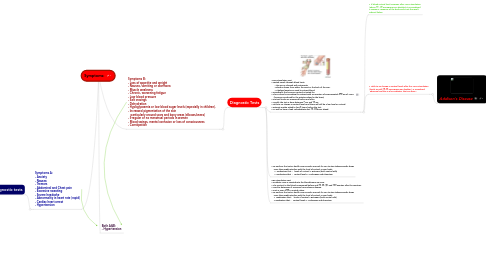
1. Symptoms A: - Anxiety - Nausea - Tremors - Abdominal and Chest pain - Excessive sweating - Severe headache - Abnormality in heart rate (rapid) - Cardiac heart arrest - Hypertension
1.1. Diagnostic tests
1.1.1. Ultrasound: - Sends cyclic sound pressure to visualize and capture size and structure of Adrenal glands - If a growth larger than usual is detected in Adrenal Medulla, a tumour might be present. - Pheochromocytoma grows in Adrenal Medulla area, abnormal sizes detected will suspect a tumour.
1.1.1.1. Positive results: This image shows a abnormally large adrenal gland, abnormally large adrenal glands is a huge indication of a tumour in the adrenal medulla.
1.1.1.1.1. Illness: Pheochromocytoma is a tumor found in the Adrenal Medulla, which is usually linked to hereditary or mutated genes. This tumour begins development from chromaffin cells, found in the core of Adrenal Glands. The tumour secretes excessive amounts of Catecholamines, resulting in the excessive amounts of Catecholamines to enter the bloodstream, which would increase heart rate, blood pressure, and other bodily functions. This may lead to cardiac heart arrest or hypertensive crisis, a high blood pressure attack. - This photo shows the possible size of Pheochromocytoma, a tumour located in the adrenal medulla.
1.1.1.2. Negative results: An ultrasound for a normal size adrenal gland would result in the severity of Pheochomocytoma to be very weak, or the patient won’t have it at all.
1.1.2. MRI Scanning: - Produces magnetic fields to generate pictures of the adrenal gland. - Due to the high blood flow present in Pheochomocytoma, it will light brightly on a MRI scan, producing very accurate results.
1.1.2.1. Positive results: The right side of the body shows a clear enlarged adrenal gland, possessing a tumor, Pheochromocytoma. The enlarged adrenal gland is easy to spot because of the tumour’s blood flow.
1.1.2.2. Negative results: The left side of the picture shows the adrenal glands to be normal sized. If both adrenal glands are this size, the patient would assumed to not have the disease.
1.1.3. Urine test: - Patients are to take a 24-hour urine test, which is collecting the patients urine for a span of 24-hours. - Specifically testing for increased Catecholamines hormone. - Generally the first test to take before any other tests, as it indicates if levels of Catecholamines are increasing or not.
1.1.3.1. Positive results: A 24-hour urine test for pheochromocytoma is considered positive if the catecholamine levels exceed two times the upper limit of normal. This is because urine expels excess of these hormones, and the existence of pheochromocytoma would greatly excrete catcheolamines.
1.1.3.2. Negative results: The 24-hour urine test is considered negative if hormonal levels of catecholamines is within range of normal.
2. Symptoms B: - Loss of appetite and weight - Nausea, vomiting or diarrhoea - Muscle weakness - Chronic, worsening fatigue - Low blood pressure - Salt cravings - Dehydration - Hypoglycaemia or low blood sugar levels (especially in children). - Increased pigmentation of the skin particularly around scars and bony areas (elbows,knees) - Irregular or no menstrual periods in women - Mood swings, mental confusion or loss of consciousness - Constipation
2.1. Diagnostic Tests
2.1.1. ATCH stimulation Test • Tested mainly through blood tests. - The area is cleaned with antispectic - Blood is drawn from either the wrist or the back of the arm. - In babies lancets are used to extract blood • Specifically the hormone cortisol is tested for. • This is done by providing the patient with an injection of approximately 250 µg of ATCH (hormone produced by the pituitary gland in the brain) • Cortisol levels are measured before and after. • Usually the test is done between 7 am and 10 am. • Little to no change in cortisol levels and there will still be a low level or cortisol. • Patients maybe asked to fast 6 hours before the test • As well as have a high carbohydrate diet 12- 24 hours ahead.
2.1.1.1. • If blood cortisol level increases after ACTH stimulation (above 18 - 20 micrograms per deciliter) it is considered a NORMAL response of the body and is not the result adrenal failure.
2.1.1.2. • Little to no change in cortisol levels after the ACTH stimulation (levels are still 18-20 micrograms per deciliter ) is considered abnormal and this is a key indicator that you have...
2.1.1.2.1. Addison's Disease
2.1.2. • To perform the tests a health care provider may ask for you to stop taking specific drugs since they might interfere with the level of cortisol in your body. • Medication that ↑ levels of cortisol = Estrogen (birth control pills) • Medication that ↓ cortisol levels = Androgens and Phenytoin
2.1.3. CRH Stimulation Test • Synthetic CRH is injected into the bloodstream via veins. • The Cortisol in the blood is measured before and 30, 60, 90, and 120 minutes after the injection. • Used to determine if someone has Cushing's disease. • Cost is over $300 in United States. • To perform the tests a health care provider may ask for you to stop taking specific drugs since they might interfere with the level of cortisol in your body. • Medication that ↑ levels of cortisol = Estrogen (birth control pills) • Medication that ↓ cortisol levels = Androgens and Phenytoin
